Introduction
Sony FE 28mm F2: Resistant shell for outdoor shooting
Designed specifically for use on full-frame Sony A7 series cameras such as the Sony A7R, the $448 FE 28mm F2 is a “fast” aperture wide-angle lens for landscape and architecture. It’s also compatible with Sony E-mount APS-C hybrids such as the A6000, where it offers an equivalent 42mm focal length, taking into account the 1.5x crop factor on the smaller sensor.
The lens features an F2 maximum aperture, Sony’s SSM autofocus motor, and internal focus, all housed inside a dust- and moisture-resistant shell that incorporates a large physical manual focus ring. If you need an even wider field of view, the FE 28mm F2 is also compatible with Sony’s $248 21mm ultra-wide angle or $298 16mm fisheye adapters that are available separately.
Key Specifications & Features
- Lens Mount: Sony FE (E mount)
- Focal Length: 28mm
- Max Aperture: F2
- Filter Thread: 49mm
- AF Motor: SSM
- Image Stabilization: No
- Length: 60mm
- Weight: 200g
Sony FE 28mm F2 Measurement: Great Sharpness and Transmission
Achieving its highest DxOMark Score of 34 on the Sony A7R, the FE 28mm F2 ranks in 134th place overall and 31st for wide-angle optics in our lens database. It’s a very respectable result that places the FE 28mm F2 towards the upper end of the performance spectrum.
The FE 28mm F2’s strongest aspects are its Sharpness lens metric score of 24P-Mpix and its Transmission of 2Tstop, which again are in the top half of the performance spectrum. Vignetting and Chromatic Aberration aren’t quite as good, and the FE 28mm’s weakest result was for Distortion, with a disappointing score of 2.1%, which affected its overall ranking.
Sony FE 28mm F2 vs Carl Zeiss Distagon T* FE 35mm F1.4 ZA vs Carl Zeiss Sonnar T* 35mm F2.8 ZA
Head-to-head against the $798 Carl Zeiss Sonnar T* 35mm F2.8 ZA, it’s very close, with the FE 28mm F2 coming out on top at 34 points to 33 points. The cheaper Sony lens wins for overall sharpness, too, 24P-Mpix compared to 22P-Mpix. At F2.8, however, the 35mm F2.8 lens is marginally sharper across the entire frame, which is important if you shoot a lot with the aperture wide open.
The new Sony lens boasts almost one stop better Transmission, too, but there’s virtually no difference for Vignetting, with scores of –1.9EV vs –1.8EV. The Sony 28mm falls down against the 35mm F2.8 for Distortion & Chromatic Aberration, however, where the 35mm F2.8 ZA posts notably better results.
Costing over three times more, the $1598 Carl Zeiss 35mm F1.4 ZA achieves the highest overall score of these three lenses with 38 points. Overall, the FE 28mm F2 achieves a slightly better Sharpness score of 24P-Mpix compared to 23P-Mpix for the Zeiss, due to its sharpness at F1.4. From F2.8 onward, however, the Zeiss 35mm is stronger and offers homogenous sharpness between F2.8 to F16. At the lens’s maximum apertures of F2 or F1.4, the FE 28mm F2 offers good sharpness in the center, but with softer corners compared to the 35mm which, although not as sharp in the center, provides more homogenous resolution across the frame. There’s not much in it for vignetting or transmission, but again there’s a big difference in both Distortion and Chromatic Aberration scores, for which the Zeiss 35mm f/1.4 is a lot stronger.
Sony FE 28mm F2 vs Sony E 35mm f/1.8 vs Sigma 30mm f/2.8 EX DN
If you’re looking for an E-mount lens with a more standard focal length (in terms of 35mm) for use on a Sony APS-C hybrid then how does the FE 28mm F2 compare? Well, tested on the Sony A5000, the results between the $448 Sony E 35mm F1.8 and the significantly cheaper $199 Sigma 30mm F2.8 EX DN are very close. With overall scores of 22 for the E-mount lenses, compared with 21 for the FE 28mm, there’s really not much in it.
The FE option does come out on top for Sharpness, with the highest overall score of 14P-Mpix, but that doesn’t tell the whole story. At F2.8, the Sigma 30mm is actually the sharpest of these three lenses across the entire frame, and although the two Sony lenses offer “faster”maximum apertures, sharpness suffers when shooting wide open with these lenses.
Vignetting and Chromatic Aberration are notably improved on the FE 28mm when it’s attached to an APS-C camera, but the Sony E 35mm F1.8 still posts the best results for fringing overall. Distortion isn’t as pronounced using the FE 28mm F2 on an APS-C camera either, but again despite the improvement, it’s still marginally worse than both the Sony E 35mm F1.8 and Sigma 30mm F2.8.
Sony FE 28mm F2 Conclusion: Solid and affordable
Ranking third for all full frame hybrid lenses, just behind two significantly more expensive Carl Zeiss options, is a great result for the Sony FE 28mm F2 lens. At a cost of just $498, and boasting a “fast” F2 aperture and solid results in most categories, it’s an affordable wide-angle solution for Sony A7 series shooters. It’s actually marginally ahead of the Zeiss wide-angle competition overall for sharpness, but isn’t quite as strong at F2.8, where the corners drop off a little. The main area of concern is Distortion, however, with quite heavy “barrelling” that landscape and architecture photographers will want to correct in post-production.


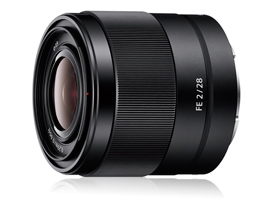


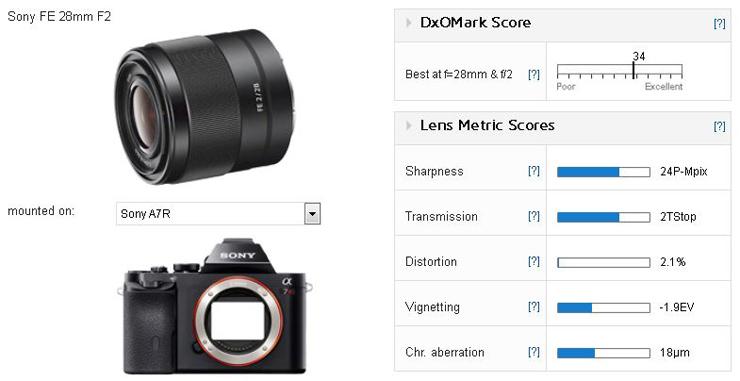

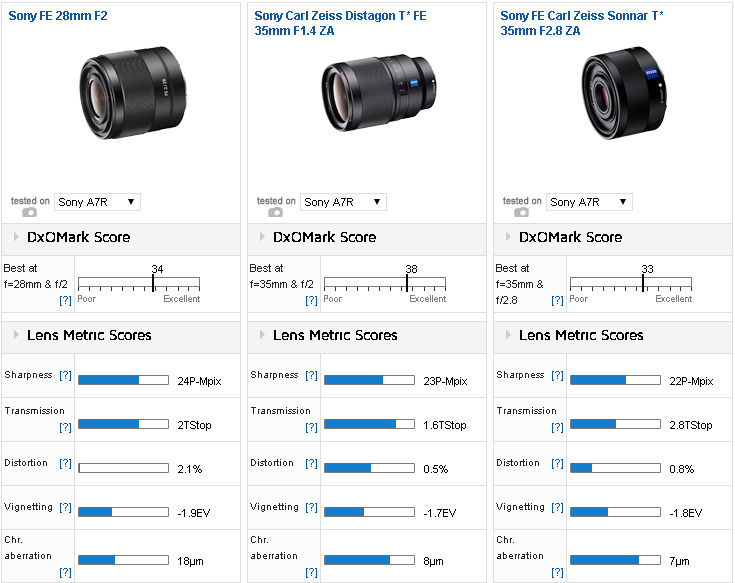

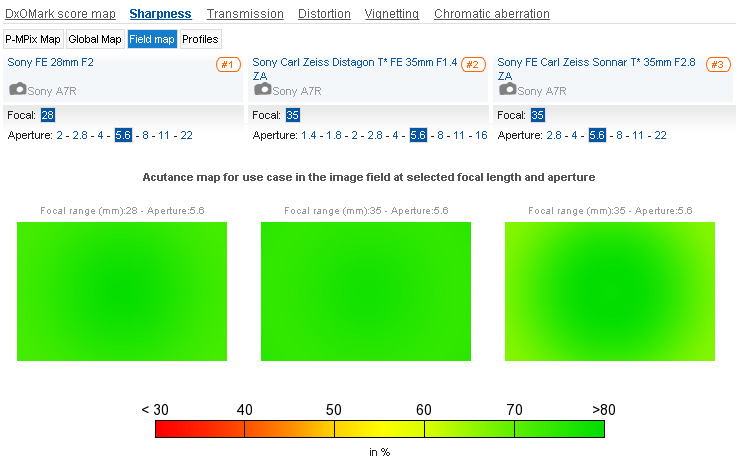

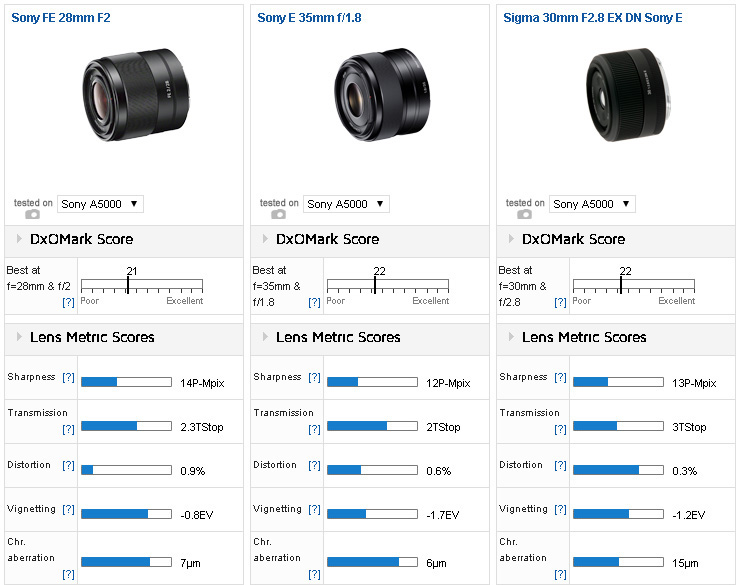
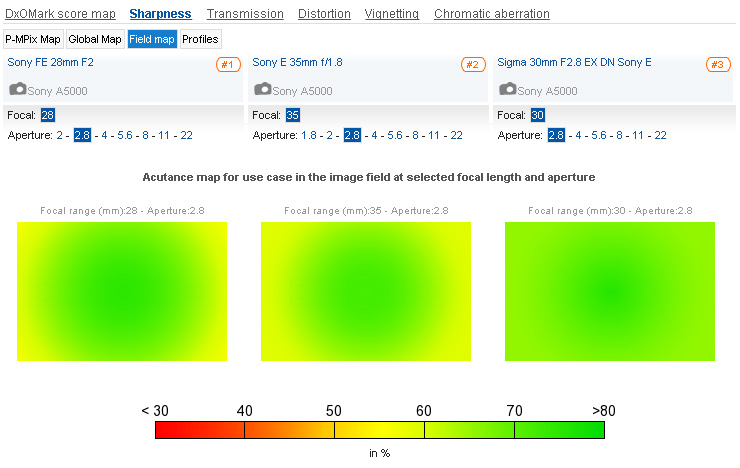
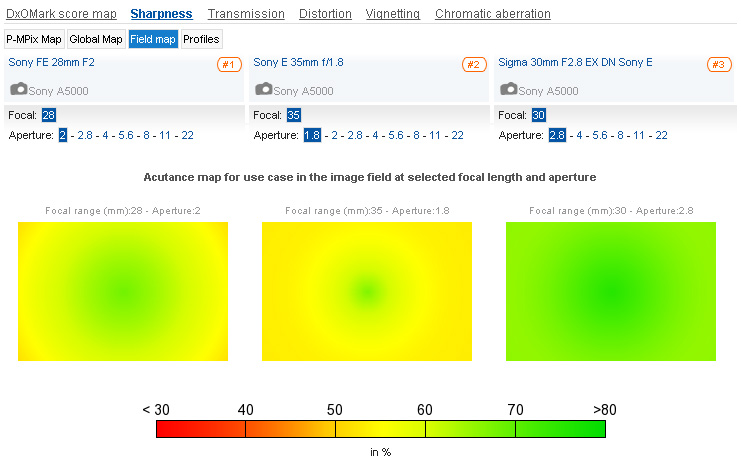

DXOMARK encourages its readers to share comments on the articles. To read or post comments, Disqus cookies are required. Change your Cookies Preferences and read more about our Comment Policy.